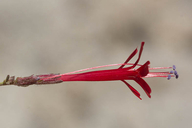Taxon Report
Ipomopsis tenuifolia (Gray) V. Grantslender-leaved ipomopsis |
 © 2018 Richard Spellenberg |
Taxon Summary
Ipomopsis tenuifolia, commonly known as slender-leaved ipomopsis, is a perennial herb in the Polemoniaceae that is found in California and elsewhere. It occurs within Chaparral, Pinyon and juniper woodland, and Sonoran desert scrub, growing at elevations from 100 to 1200 meters. Ipomopsis tenuifolia is ranked 2B.3, Plants Rare, Threatened, or Endangered in California, But More Common Elsewhere; Not very threatened in California.Classification
|
Scientific Name: |
Ipomopsis tenuifolia (Gray) V. Grant |
|
Common Name: |
slender-leaved ipomopsis |
| Family: | Polemoniaceae |
| Element Code: | PDPLM060J0 |
| USDA Plants Symbol: | IPTE3 |
|
Synonyms/Other Names: |
|
Ecology and Life History
| Lifeform: | perennial herb |
| Blooming Period: Mar-May | Mar-May |
| Elevation: | 100-1200 (330-3935) |
| General Habitats: | Chaparral, Pinyon and juniper woodland, Sonoran desert scrub |
| Microhabitat: | Gravelly (sometimes), Rocky (sometimes) |
| Microhabitat Details: |
Conservation Status
| CA Rare Plant Rank: | 2B.3 |
| Global Rank: | G4 |
|
State Rank: |
S2 |
| State List: | None |
| Fed List: | None |
| Other Status: | SB_CalBG/RSABG |
|
CRPR Changes: |
|
Occurrence Data from the CNDDB
| Total Occurrences: | 17 |
| Element Occurrence Ranks: | |
| Excellent (A) | 0 |
| Good (B) | 3 |
| Fair (C) | 1 |
| Poor (D) | 0 |
| None (X) | 0 |
| Unknown (U) | 13 |
| California Endemic: False | |
| California Counties and Islands: Name (Code) | |
| Imperial (IMP), San Diego (SDG) | |
| Quads: Name (Quad Code) | |
| In-ko-pah Gorge (3211661), Jacumba (3211662) | |
Threat List Data from the CNDDB
| Threat List Total: | 4 | |
| EOs with Threat Listed: | Total EOs | % of EOs |
| 5 | 29 % | |
| Non-native plant impacts | 3 | 17% |
| ORV activity | 3 | 17% |
| Vandalism/dumping/litter | 2 | 11% |
| Foot traffic/trampling | 2 | 11% |
Citation
California Native Plant Society, Rare Plant Program. 2025. Rare Plant Inventory (online edition, v9.5.1). Website https://www.rareplants.cnps.org [accessed 23 December 2025].